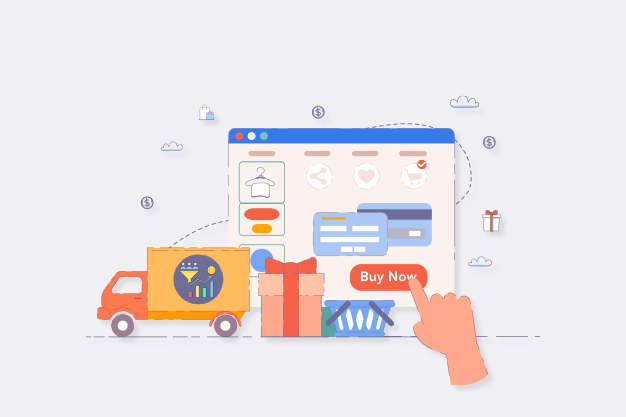Looking to enhance your ecommerce website design and boost your conversion rates? We will explore the importance of ecommerce web design for increasing sales and revenue.
From optimizing for mobile devices to incorporating user reviews and ratings, we will provide practical tips to improve your ecommerce web design. We will discuss common mistakes to avoid and how to measure the success of your efforts.

Let’s take your online store to the next level!
Why is Ecommerce Web Design Important for Conversion Rates?
Effective e-commerce web Design is crucial in boosting conversion rates by optimizing the online shopping experience and guiding users towards purchasing.
One key aspect that significantly influences conversion rates is the layout of the website and the placement of call-to-action buttons. You can hire an eCommerce developer to get a beautifully designed and high-converting ecommerce site. A user-friendly design with intuitive navigation and clear product presentation can compel visitors to engage more and complete the checkout process.
Ecommerce Web Design can reduce cart abandonment rates and encourage customers to finalize their purchases by streamlining the checkout process, removing unnecessary steps, and providing multiple payment options. These design elements create a seamless path for users, making it easier to convert from browsing to buying.
What are the Common Mistakes in Ecommerce Web Design?
Many ecommerce websites make detrimental design mistakes that negatively impact the user experience and conversion rates. By being aware of these common pitfalls, online stores can avoid them and create an optimal design. One major mistake is having a cluttered, disorganized layout. Too many elements crammed together overwhelms visitors and makes it difficult for them to find products. This leads to frustration and high bounce rates as customers leave the site. To fix this, simplify the layout and visual hierarchy. Draw users’ attention to critical items and calls to action.
Another significant error is slow page loading speeds. Research shows even minor delays of a few seconds lead many users to abandon a site. Optimizing site architecture and image sizes results in faster load times, keeping customers engaged. Neglecting trust factors also deter sales. Customers want reassurance before providing personal information. Security badges, customer reviews and testimonials build credibility. Transparent communication and prompt answering of questions also foster trust.
Insufficient product descriptions confuse customers and cause missed sales opportunities. Highlight features and benefits that address the buyer’s needs. Use persuasive language and evoke emotions to captivate shoppers. Finally, complicated checkout processes with too many fields and steps lead to abandoned carts. Simplify by allowing guest checkouts, adding progress trackers, and providing multiple payment options.
Analyzing competitors’ site performance and UX is worthwhile for gaining insights for improvement. Correcting these common mistakes results in better customer experiences and increased conversions.
Tips for Improving Your Ecommerce Website Design
To create a top-notch ecommerce website that converts visitors into buyers, focus on these key elements:
- Optimize for mobile devices: In today’s world, most online shopping happens on smartphones and tablets. Make sure your site loads fast and looks great on all screen sizes.
- Simplify navigation: Use clean, well-labelled menus and categories so customers can easily find products. Avoid confusing or cluttered menus.
- Use visuals: Show off products with high-quality images and videos. Compelling visuals build excitement and trust.
- Test design options: Try different layouts, colors, and button placements to see what converts best. A/B testing provides data-driven insights.
1. Optimize for Mobile Users
Optimizing for mobile is crucial, as mobile traffic drives more and more sales. Ensure your site loads fast on mobile and all elements work seamlessly.
- Use responsive design so the layout automatically adapts across different device screen sizes. Consistent navigation and images that resize fluidly are essential.
- Monitor site speed and fix any mobile lag issues.
- Quick load times keep mobile users happy and engaged. Responsive images also improve mobile speed. They load faster by automatically adjusting the file size for the screen.
- Creating a unique mobile experience means more mobile sales. Don’t let tech issues derail customers.
2. Simplify Navigation for a Smooth Shopping Experience
Well-designed navigation makes it easy for customers to find and purchase products on your ecommerce site.
- An intuitive flow allows users to browse and check out seamlessly. This increases engagement and conversions.
- Clean menus and categories guide visitors to products efficiently like a roadmap. Avoid clutter.
- Add search to let shoppers quickly find specific items. Fast searches enhance their experience.
You create a user-friendly site with simplified navigation that encourages exploration and sales. Focus on making key site sections intuitive to navigate.
3. High-Quality Images and Videos Show Off Products
Use top-notch visuals in your ecommerce web design to capture attention and portray products in the best light.
- Strategically arranged, high-res product photos and videos can highlight features and showcase benefits to guide buyers.
- Compelling visuals spark excitement and positively influence purchasing decisions.
- Immersive multimedia content helps customers visualize using products, building engagement. Strong visuals also reinforce brand image and establish trust.
- In ecommerce, visual appeal matters. Invest in quality images and videos that make products shine. This drives greater user engagement and conversions.
4. User Reviews Build Trust and Credibility
Implementing user reviews and ratings on your ecommerce site provides trust and social proof that influence buying decisions.
- Authentic customer feedback validates products and helps potential buyers feel confident purchasing.
- A robust review system shows your products’ reliability and boosts your brand’s credibility.
- By letting customers share experiences, you gain powerful trust-building content and higher conversions.
5. Offer Multiple Secure Payment Methods
Give customers payment options at checkout to increase convenience and reduce cart abandonment.
- When you allow payments by credit card, e-wallets, bank transfer, Buy Now Pay Later, etc., more customers will complete purchases.
- Secure encrypted gateways also build trust in your ecommerce platform. Protecting transactions enhances satisfaction and loyalty.
- Providing a range of accessible, trusted payment methods caters to customer preferences. This leads to more completed sales and repeat business.
6. Strategic CTAs Guide Users to Convert
Well-designed calls-to-action (CTAs) prompt visitors to take desired actions like purchasing.
- Place CTAs at critical points on your ecommerce site. Compelling copy and eye-catching buttons encourage clicks.
- Conversion tracking tools let you optimize CTAs for better results over time.
- Offering discounts or deals boosts engagement, too.
- Strategic CTAs seamlessly guide users through the conversion funnel from interest to purchase.
7. Simplify Checkout for Happier Customers
An easy checkout process minimizes frustration and boosts completed transactions.
- Ensure seamless, uncomplicated checkout to increase purchase likelihood. Fewer fields and steps keep customers happy.
- Order confirmations bring a sense of reassurance that the transaction succeeded.
- Secure, optimized payment gateways also build trust in your platform.
- Strategically offer discounts via exit popups to capture abandoned carts.
- Smoother checkouts improve user experience, reduce cart abandonment, and lift conversion rates.
8. Leverage Social Media to Boost Engagement
Integrating social media into your ecommerce site can increase brand visibility and facilitate product sharing.
- Showcasing user reviews, testimonials, and photos builds trust and influences buying decisions through social proof.
- Social media also enables retargeting campaigns to reconnect with interested shoppers.
- Real-time social interactions foster community and valuable user-generated content.
9. A/B Testing Optimizes Conversions
A/B testing different versions of site elements identifies what resonates best with your audience. You gain data-driven insights into customer preferences by testing page layouts, content, buttons, etc.
- Closely monitoring click-throughs, bounce rates, and conversions reveals optimization opportunities.
- Ongoing experimentation enables informed improvements that increase conversions over time.
- A/B testing pinpoints winning variations that maximize sales and user experience.
How Can You Measure the Success of Your Ecommerce Web Design?
Running an online store means keeping track of how well your website works. You need to get visitors, keep them interested, and get them to buy stuff like an actual store. Here are some significant numbers to watch:
1. Turning Visitors into Buyers:
Imagine 100 people come to your bakery site. 15 add yummy treats to their cart and buy them. Your buyer rate is 15%.
- A high buyer rate means your site gets visitors to buy effectively.
- Improve your site to make it easy to find and buy products. Use big “Buy Now” buttons. Make checkout fast.
2. Keeping Visitors Engaged:
Picture people briefly glancing at your shop and then leaving without looking further. This is like a high bounce rate – when visitors leave your site quickly.
- A high bounce rate means your site is confusing, slow or tedious. Visitors don’t want to explore.
- Make your site enjoyable with good pictures, product descriptions, and content. Speed up load times. Make navigation easy.
3. Making More Money Per Sale:
One customer buys a $15 t-shirt. Another buys a jacket, jeans, and shoes for $100. Your average money per order is $57.50.
- A higher average means customers spend more per purchase. You make more money.
- Suggest add-on products customers might like. Offer bargains on product bundles. Recommend items based on past purchases.
4. Bringing Customers Back:
A loyal customer orders monthly from your bookstore, spending $30 each time. In a year, their value to you is $360.
- This number shows how much money a long-term customer brings you. Keeping these customers costs less than finding new ones.
- Offer rewards programs, personalized deals, and excellent service. Turn one-time shoppers into repeat buyers.
Watch these key numbers to understand your site’s performance. Use them to make smart choices and get more shoppers buying more often.
Frequently Asked Questions
1. How often should I update my ecommerce site’s design?
You’ll want to periodically refresh your ecommerce site’s design to keep it modern, clean, and appealing. Aim for a significant redesign every 2-3 years and minor updates every 6-12 months. Stay on top of design trends and new features.
2. Should I hire a designer or use a DIY ecommerce platform?
Hiring a professional designer is recommended for a custom, high-converting ecommerce site. However, DIY platforms like Shopify offer easy design templates if you’re on a tight budget. Consider your business needs and resources.
3. What’s the average cost to design an ecommerce website?
The cost can vary widely, but expect to invest $5,000 – $15,000+ for a custom ecommerce site design. Factor in ongoing maintenance, too. Cost depends on features, customization, and whether you hire a designer.
4. How can I split-test my ecommerce site’s design?
Use A/B testing tools to try out variations of design elements on your live site. For example, test button color, page layouts, images, etc. Monitor how changes impact critical metrics like conversions. Testing informs design optimization.
To Conclude
Watch these key numbers to understand your site’s performance. Use them to make smart choices and get more shoppers buying more often.
To summarize, effective ecommerce web design is essential for boosting conversions and revenue. By optimizing your site for mobile, simplifying navigation, using compelling visuals, building trust through reviews, streamlining checkout, and experimenting with A/B testing, you can significantly improve the online shopping experience. This will turn more of your site visitors into customers.
If you need help taking your ecommerce site to the next level, consider partnering with an ecommerce development company. Your online store can unlock its full revenue potential with the right design strategy and expert implementation from a professional team.
